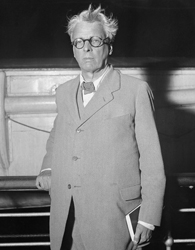William Butler Yeats, a romantic, poet, playwright and senator, drew on national pride, spiritualism and love, and was credited with helping revive interest in Irish literature.
William Butler Yeats’ Early Days
William Butler Yeats was born on June 13, 1865, in Sandymount, County Dublin, Ireland, to John Butler Yeats, a portrait painter, and Susan Mary Pollexfen. His parents, two younger sisters and brother moved to England when he was two. Yeats’ mother’s stories about Ireland were an early inspiration for the spiritual and mythical elements of his poems.
After attending school in Hammersmith, England, and pursuing poetry in Ireland, he published his first poems in the Dublin University Review. Yeats’ first collection, “The Wanderings of Oisin,” appeared in 1889.
It is impossible to mention Yeats without mentioning his muse, the fiery Irish patriot Maud Gonne, whom he met in 1889. Her exquisite beauty, coupled with her bravery, inspired many of his works.
Sadly, she rejected Yeats, telling him, “You make beautiful poetry out of what you call your unhappiness, and you are happy in that. The world should thank you for not marrying me.”
Sources in this Story
- The Literature Network: William Butler Yeats–Biography and Works
- Time: Death of a Patriot
- The Atlantic: William Butler Yeats
- BBC 4: Yeats and Irish Politics
- The Nobel Foundation: Nobel Prize in Literature 1923
- Yeats Society: W.B. Yeats
Yeats’ Poetry and Plays
Yeats wanted to restore Ireland’s ancient culture and mythology, long suppressed by the country’s English rulers. In support of this aim, Yeats helped to found the Abbey Theater in 1904.
In 1938, Louise Bogan wrote in The Atlantic, “Ireland in Yeats’ young manhood was as ungrateful a soil for art as any that could be found, in a particularly materialistic time. The native Celtic genius…had been, for over a century, drawn off into politics.”
Yeats’ work also had more overtly political inspirations. His poem, “Easter 1916,” memorialized the failed May 1916 coup known as the Easter Rising in which the English executed 15 Irish rebels, including Maud Gonne’s husband, John MacBride.
In a BBC Radio 4 program, Fran Brearton of Queens University speaks about the poem and Yeats’ play “Cathleen ni Houlihan,” describing Cathleen as “the inspirational figure, the embodiment of Ireland in the guise of a woman [there] so that the male revolutionary will then sacrifice himself for the love of a beautiful woman.” Maud Gonne, who was also an actress, played Cathleen in the play’s premiere.
The Rest of the Story
Yeats courted Gonne for two decades, but never married her. He even unsuccessfully courted Gonne’s illegitimate daughter, Iseult, according to the Literature Network. He married Georgina Hyde Lees in 1917, and they had two children: Anne and Michael.
In 1923, Yeats was awarded the Nobel Prize for Literature. In the presentation speech, Per Hallstrom, the Nobel committee chairman, credited Yeats with leading the “Celtic revival…which created a new national literature, an Anglo-Irish literature.”
Yeats died in France on January 28, 1939. He was buried there, but in 1948 was reburied in Ireland, according to his wish, “under bare Ben Bulben’s head in Drumcliff churchyard.” His epitaph reads: “Cast a cold Eye/On Life, on Death./Horseman, pass by!”
Yeats Resources Online
- The Poetry Archive has a 1932 recording of Yeats reading one of his best-known works, “The Lake Isle of Innisfree.”
- Poet’s Corner has several of his poems available.
- His first collection, “The Wanderings of Oisin,” is available in the Dulcinea Media Store.
- The National Library of Ireland has an outstanding interactive Yeats exhibition that includes a visual timeline of his life and work, photos of original manuscripts and recordings of Yeats reading his poetry.
This article was originally written by Shannon Firth; it was updated May 19, 2017.











